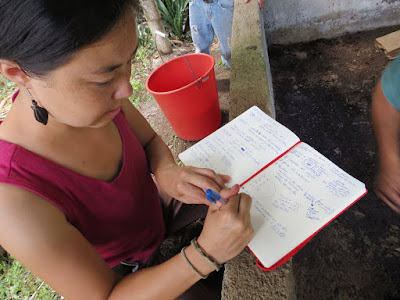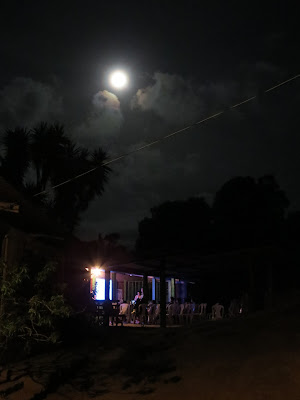 |
| ATC interns + FEM representatives in Rosario |
This week I had the chance to visit one of ATC’s partner
organizations in Nicaragua, the
Fundación Entre Mujeres (FEM).
Founded in 1995 by a group of 14 women from communities throughout Northern Nicaragua, the FEM works to defend
the rights of rural women.
They see
gender equity in rural communities in a way that is very tied to the relationship with
land, and thus many of their programs focus on access to land, to food
production, and building rural women livelihoods through agriculture.
Nicaragua has a long history of
machismo culture, like the world at large. The role of women is typically to work in the kitchen and take care of children. Women traditionally lack access to educational opportunities, to choose an alternative livelihood, or to manage a family's financial resources. As I heard from many women during my visit
with the FEM, there is also a major problem with domestic violence against
women in rural communities, and it regularly goes on without challenge.
Another part of the historical discrimination against women
in Nicaragua occurred during the Sandanista agrarian reform in 1979. While there were many positives of the
agrarian reform (which redistributed land to peasants), women were not included
in this distribution of land. This of
course is not a unique story. While the
majority of small-scale producers in the world are women, very few own their
own land. In other words, women are
feeding the world, but they often lack the autonomy that they deserve.
It is with this context that the FEM developed and continues
to work in today. All of their projects
work with a feminist lens and on empowering women economically, ideologically,
and organizationally. They work to
situate women in the public sphere (no longer just in the kitchen) and in
leadership positions in their rural communities. To see how the FEM works in action, I got to visit a few
rural communities and learn directly from women involved in the FEM what they
are working on and how they are doing it.
 |
| Walking around Los Llanos. |
In the mountains north of Estelí in the community of Los
Llanos (population 1300), I visited a women’s agricultural cooperative called
COPEMUJER (Cooperativa Multisectorial Mujeres del Norte, or the Northern Women’s
Multi-Sectoral Cooperative). The 45
cooperative members grow a variety of agricultural products including basic
grains, hibiscus, chia, and vegetables. They are most well known for
their coffee production, which is certified organic and fair trade and is sold
in parts of the United States and Europe.
 |
| Coffee beans |
In 1996, a group of 5 women
in the Los Llanos organized to become land owners on a nearby
hillside and founded COPEMUJER. (The FEM helped them purchase
the land and organize the cooperative.) We visited the land that is
still worked to this day by one of the cooperative's founders (with the help of others, including her
daughter). We also toured some of the other parcels of land where cooperative
members work.
 |
| Walking in the fields around Los Llanos. |
 |
| Tasseling corn. |
 |
| Learning to plant hibiscus. |
A major struggle that producers of Los Llanos are facing now
is climate change. The region has
become substantially drier during the rainy season. I saw many
crops of corn and beans that were going to be used to feed families' animals because
they were had not developed enough to produce fruit. Another
major issue the women are having now is with their coffee crops. Coffee trees around the region are being devastated by a disease known as “la roya”, a fungus
that attacks the leaves, spreads easily, and substantially reduces
production. This disease is also linked with
the drier climate due to climate change. These crop failures mean that more families run out of food and that they have less income from coffee.
 |
| A coffee plant leaf infected with la roya. |
While these are grand challenges, the women producers of Los Llanos
working on ways to adapt production to the drier climate.
They are
testing out different methods of coffee production and different coffee
varieties to see which are most resistant to la roya.
Some are looking to integrate more
drought-resistant crops such as hibiscus and experiment with other crops like
chia.
They are also actively learning and
implementing a variety of agroecological production techniques including the
use of compost, intercropping, and agroforestry.
 |
| Checking out the new compost system. |
 |
| Lookin' good! |
 |
| Agroforestry system of fruit trees, corn, and vegetables. |
 |
| Coffee and fruit tree intercroppings. |
In the village of El Rosario (population 480 families), women
are also working on implementing a variety of agroecological production
techniques and adapting to a drier climate.
20 of the 50 women in the village who collaborate with the FEM are
learning and practicing biointensive production methods for their home gardens.
In El Rosario, I got to see a very important project of
the FEM, which is the community seed bank.
Women in each community maintain a reserve of native seeds and ensure that
varieties are planted and saved each year.
Not only is native seed saving important for biodiversity, but it also
supports the women to in producing food for themselves autonomously from the
market and from men.
 |
| Rosarios' seed bank. |
 |
| A variety of red beans, a Nicaraguan favorite. |
 |
| Sorghum seeds for tortillas. |
In these rural villages, the FEM has also provided many other resources for women. They helped many adult
women go to school to earn a bachelors degree and many other young women
receive university scholarships.
They coordinate sexual health workshops.
They provide animals (for milk, cheese, eggs, meat, and soil fertility)
to women in need. In each village where
they work, they have helped women construct their own houses (many women are
single mothers). Each village has a FEM organizational house for meetings, courses, a seed bank, and other supplies. Over and over again, I
heard from women that, with the help of FEM, they were able to change their
lives for the better and organize successfully in their communities with other
women.
After visiting Los Llanos and El Rosario, we traveled to
the Central de Cooperativas Multisecoriales de Mujeres Rurales
Feministas-Ecológicas, located just outside of Estelí.
The Central supports the creation and
distribution of organic food products from 6 (soon to be 8) women cooperatives.
Here, various raw products that come from
rural community cooperatives are processed and prepared for market in certified
commercial facilities.
For example, the coffee
grown by women in rural communities (such as Los Llanos) is toasted, ground,
and packaged here.
As income from coffee
decreases (due to less production), cooperatives that traditionally focused on
coffee only are also looking for other ways to gain income.
The women are now processing hibiscus flowers
into tea, wine, and jam.
They also
recently tested out making mango wine (mangos grow plentifully here with little
effort), which sold very successfully at the local market.
The production and commercialization of
value-added products is an important income source for the women.
 |
| The Central's coffee toaster. |
 |
| Coffee packaging for Denmark. |
 |
| Drying lemongrass for tea. |
 |
| Hibiscus tea and jam. |
There is also plentiful space at the Central for the propagation of coffee
tree starts, for vegetable trays, for various biofertilizers, and for compost.
These are distributed to communities once
they are ready to go.
 |
| Many coffee varieties are being grown here. |
 |
| Baby coffee. |
 |
| Baby beets. |
For a single producer or a single cooperative, constructing
and maintaining such a facility, as well as going through the appropriate
processes for organic, fair trade, and sanitary certification, would be a major
cost and challenge.
However, this
facility, which began as a project of the FEM (and now functions as partner),
allows rural women producers to collectively share the costs of processing.
It also creates jobs for 13 workers, who are women from the rural areas where FEM works.
In my two days with the FEM, I was able to get a glimpse
into the life of rural women in Nicaragua and see a powerful organization in
action.
As in the States, I’ve heard
many people give lip service to gender equity.
The FEM is actively producing it.
In fact, it’s been such a success story that it is being shared around
the world, and they receive visitors daily who come to learn what FEM does and
how they do it. As FEM staff told me, these visits also are a way for feminist organizers from around the globe to exchange challenges and ideas for combating struggles that still exist in the work for gender equity.
 |
| ATC interns + FEM representatives in Los Llanos |
 |
| Intergenerational, international exchange in Los Llanos. |
What was especially inspiring for me during my visit was to meet
confident women in their late teens and early 20s who were already actively
involved in food production or studying topics like agriculture and rural
development in university. They planned
to earn a livelihood through agroecological food production, and were proud of
it. I was reminded of the vigor of
beginning farmers that I’ve met in my home state through programs like Rogue
Farm Corps. Without a new generation of politically
aware farmers across the globe who grow ecologically on small-scales, we’re in
for real trouble. I hope to see this
movement continue to grow, near and far from wherever I am.









































